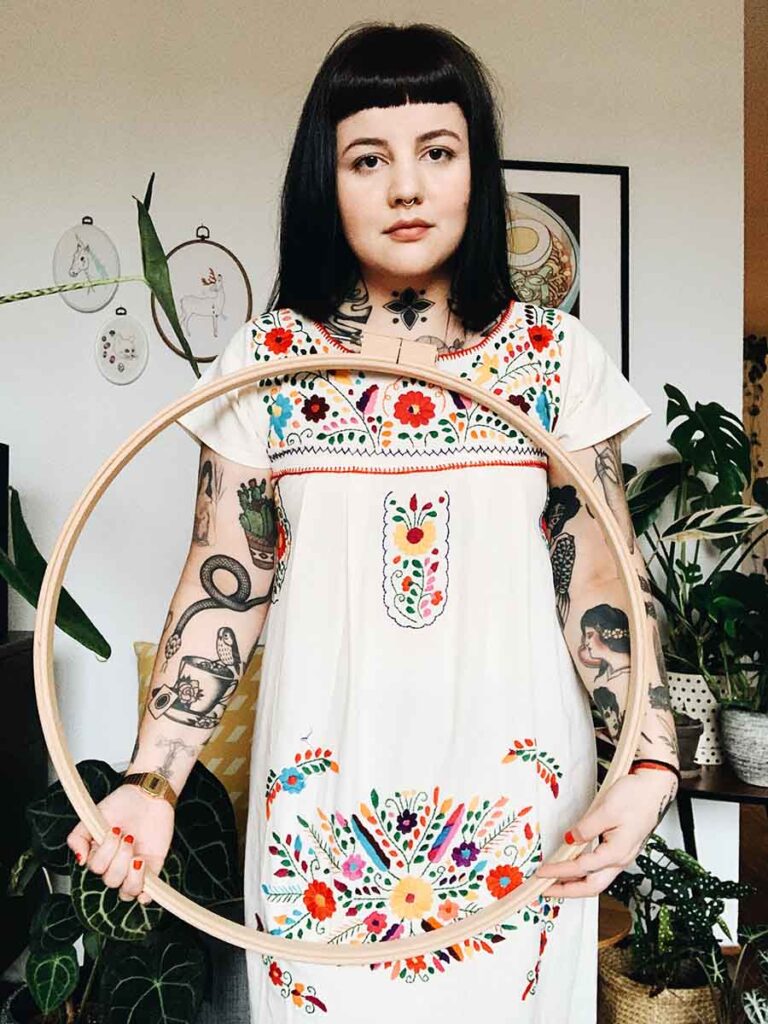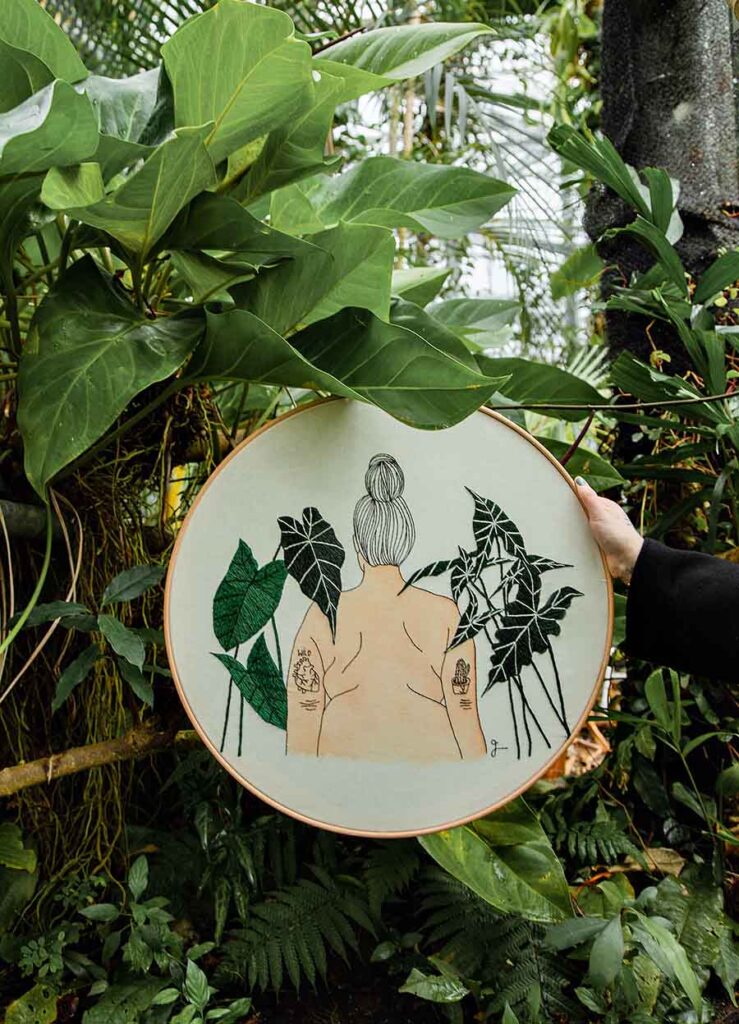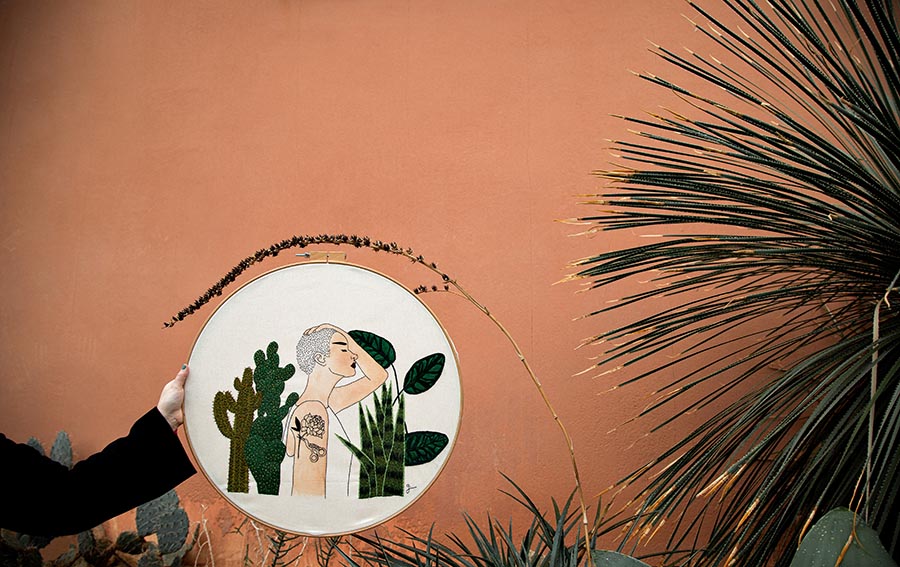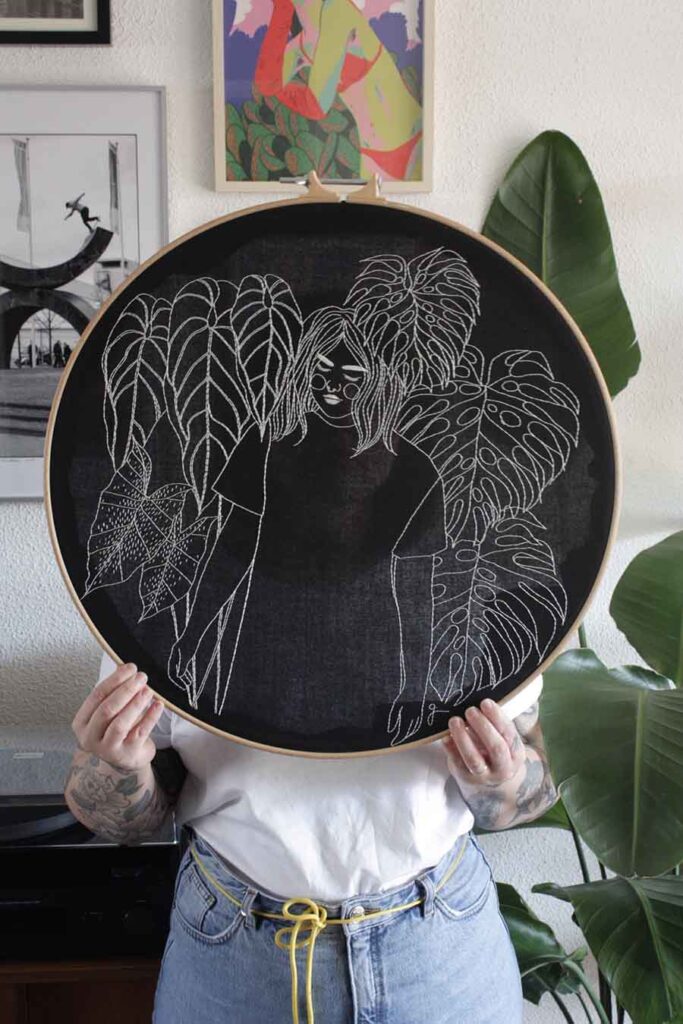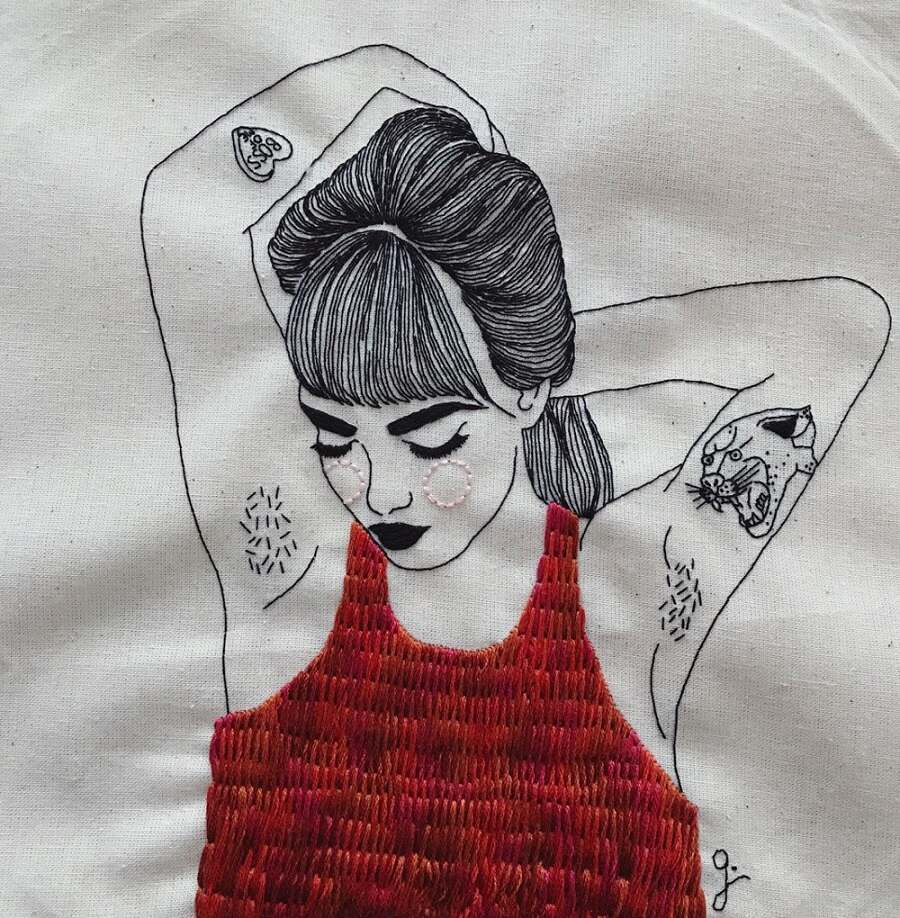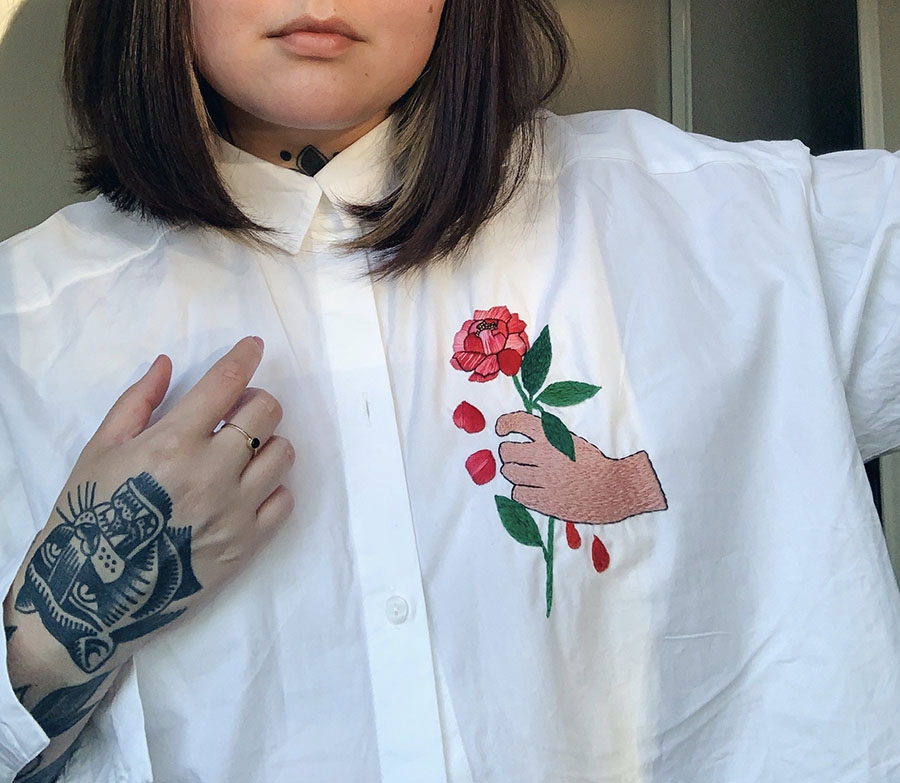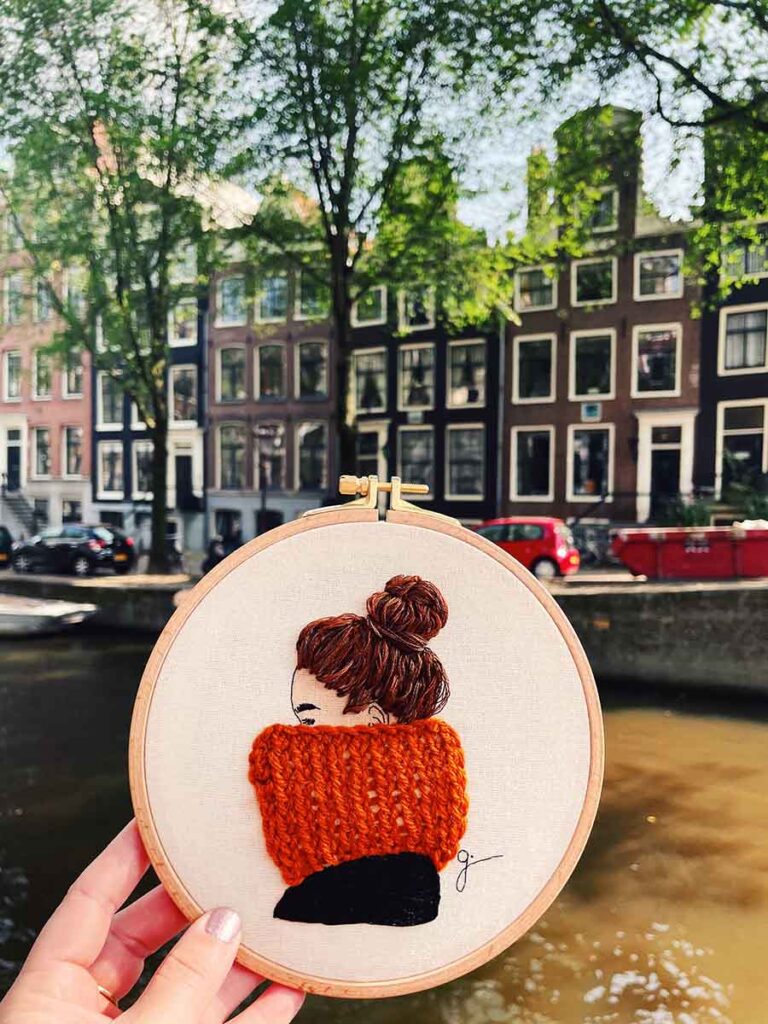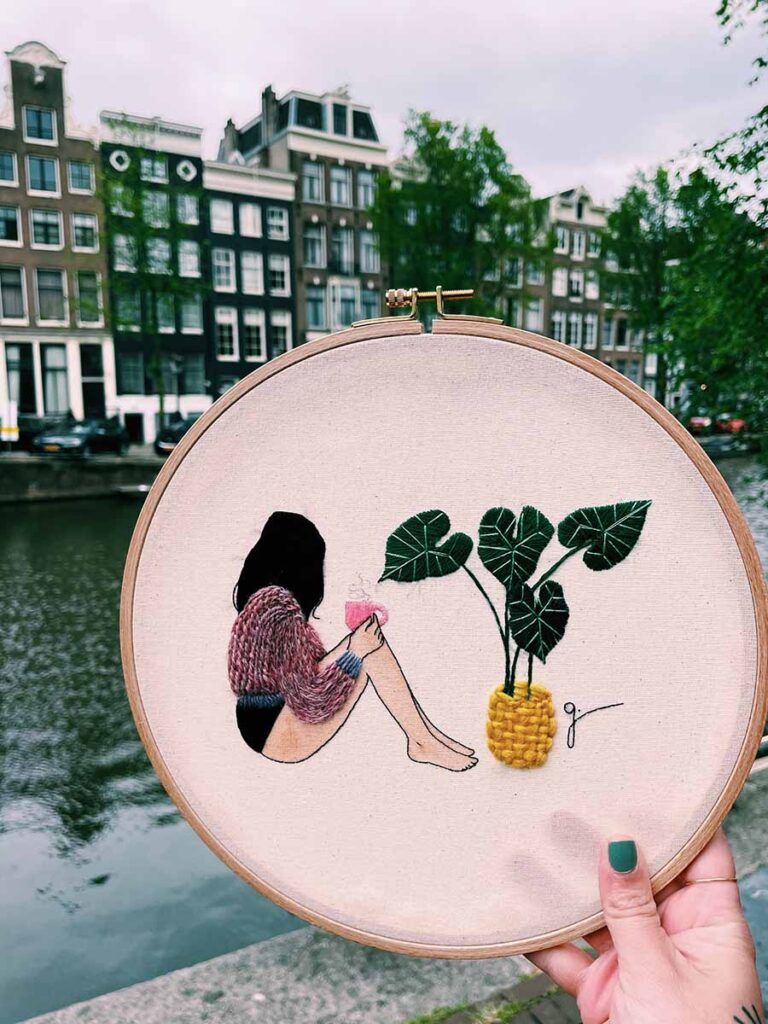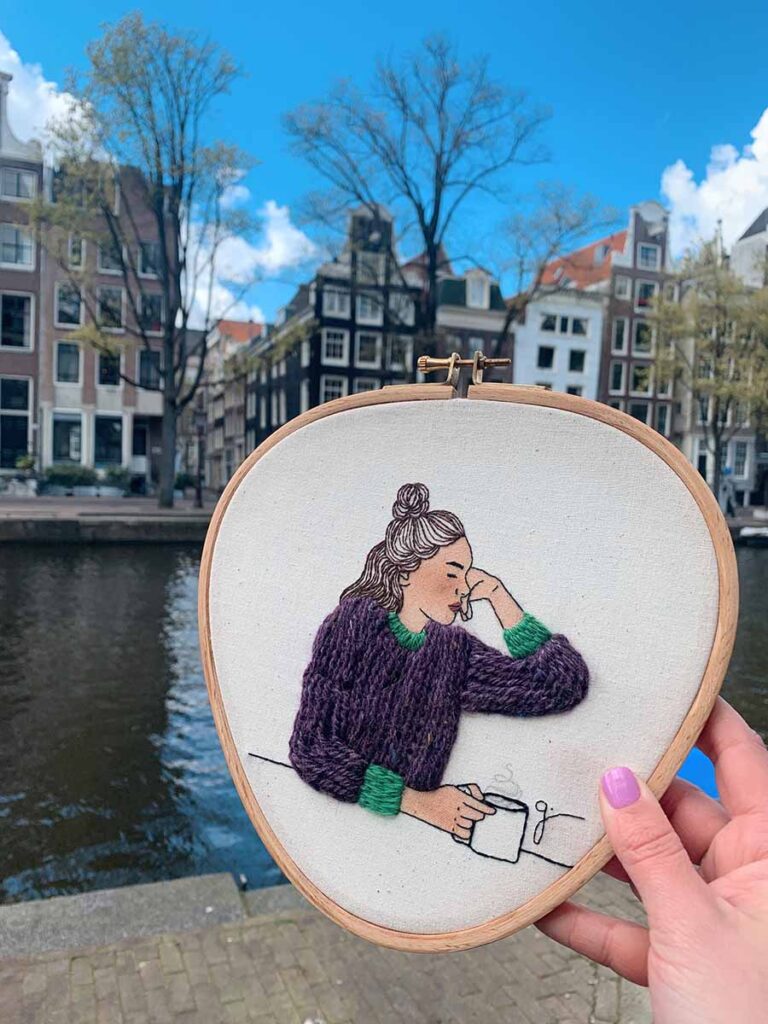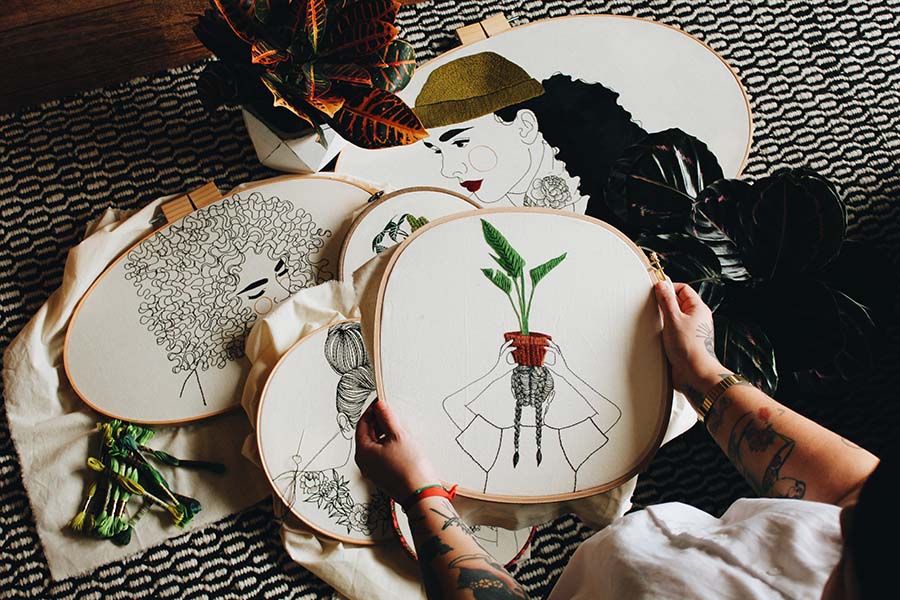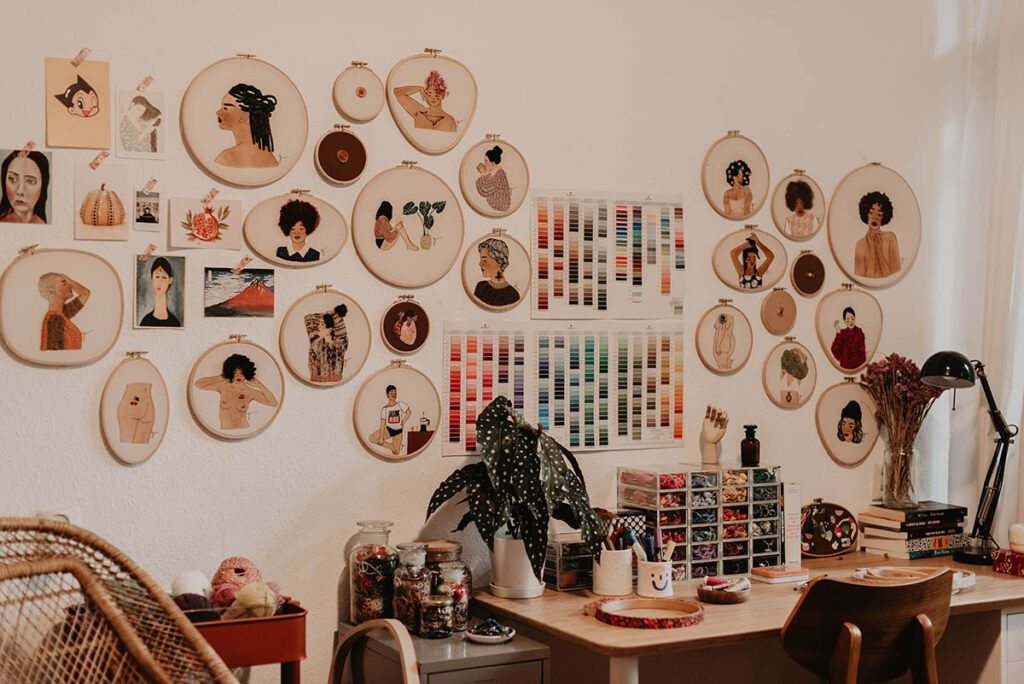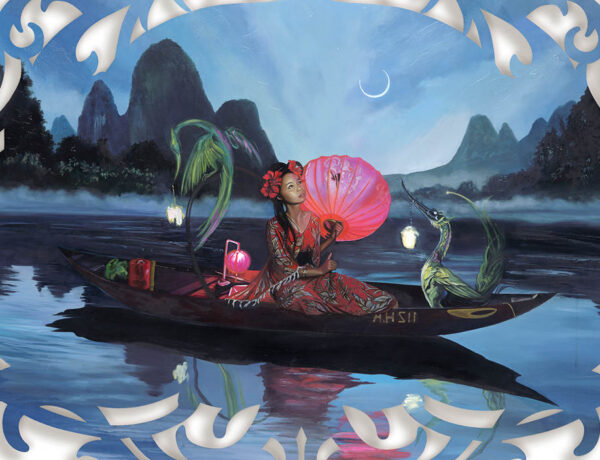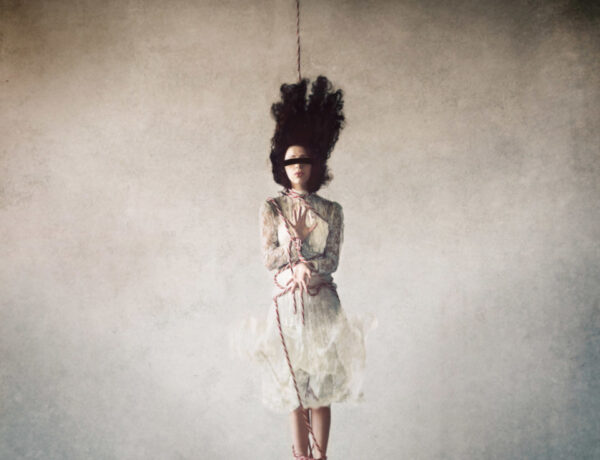In considering social activism and art, the craft of embroidery likely isn’t the first medium that comes to mind. Yet when Brazilian artist Giselle Quinto came to it as an activity to aid her in coping with the challenges of new motherhood, she soon discovered that practicing this art form provided her with more than a means of healing. After a lifetime of watching her mother, aunts, and grandmother crochet without ever having been introduced to any of its manual techniques, she realized that this tactile mode of self-expression not only unearthed a deeper connection to her roots but also armed her with a new sense of empowerment. Drawing minimalist lines in embroidery floss as if sketching in pencil, she depicts portraits of young, contemporary women as a statement of inclusivity.
Bucking conventional standards of beauty stitch by stitch, Giselle Quinto’s artwork prominently features full-figured bodies, women of color, and natural hair. The textures and saturated tones created through the combination of thread and gouache paint infuse an otherwise quiet, delicate medium with a distinctive feminine energy and allure. The result of which gives the women in her work a voice to say ‘we are here, and we are beautiful too’.
Interview with Giselle Quinto
What are your early memories of art from your childhood and growing up in Brazil?
I remember playing with my cousin and my great-grandmother with dolls, making a rug out of patches. Also the scent of the mango, the lemon clove. I had a very happy childhood. I always went to my grandmother’s farm, spent a lot of time hanging in trees, running. I can’t remember when art entered my life, it seems that it was always present. As a child, I accompanied my father to painting class and loved the smell of the paint. I always liked drawing, as a teenager I became even more interested. Drawing was a refuge.
Did you always have a connection to embroidery? How did you learn the process?
Handcrafting has never been in my life. My mother, grandmother, aunts – they all did crochet, which is very natural in Brazil as means to have extra money, but no one ever taught me any manual technique.
Embroidery randomly appeared in my life in 2012. At the time, I was unemployed. I had just given birth to my daughter and was lost and depressed. Motherhood had turned me inside out. A friend of mine suggested that I start embroidering my own designs using a starter kit that she was selling. Embroidery was not easy for me at first. Understanding the stitches without a teacher was very challenging. But I tried to follow something intuitive in me. I was trying to get closer to my drawings, using a few lines and gradually understanding this universe, which was already so familiar. Facing my fears with courage through art was the way I found to understand, reframe, accept, and even heal parts of my story.
Facing my fears with courage through art was the way I found to understand, reframe, accept, and even heal parts of my story.
Have figures of women been your preferred subject from the beginning? If so, are the ones often seen in your works imagined characters or people you know?
It was always about women. Digging and submerging issues related to various female beauties has always been my motivation. Most have been women from my imagination. In addition to this, however, I also embroidered friends as a way to connect my work to reality. Strong women who I admired so much were a good starting point.
You mention in your artist biography that your work acts as a ‘protest for equality’. I’d love to hear more about how you’re making a statement through embroidery art.
I come from a very sexist and racist country. Initially, I never thought I could act artistically against these movements, which are so ingrained in my culture. I only embroidered white women, thin, with straight hair. I was reproducing an art that wasn’t inclusive, that didn’t represent me or many other excluded women from our society.
The biggest turning point in my work was when I realized that I could show other beauties, those that are forgotten, silenced. It was a very deep dive to embroider curly hair, bald women, and fat women. I keep trying to take this more critical look at what beauty I’m reproducing and it makes me grow artistically.
What else are you exploring in your work currently?
I have been studying the possibility of launching a used clothing brand for a long time. Vintage clothes revisited with embroidery. So far, I’ve been trying this on jackets and shirts.
Speaking about the formal aspects of your embroidery art, I most enjoy the balance between the minimalist linework and the textures created within the filled-in areas. What are some of the stitching techniques or tools you use and how did you develop your style?
For a long time, I searched for an embroidery style that was closer to pencil on paper. That was cleaner, minimal, and it visually pleased me. Over time, I organically added elements of color and texture. The first element that I felt the need to embroider besides women was the plants. There’s such a strong feminine connection to nature. Being close to plants takes me back to my country. Painting the cloth came next. Painting these women, first with watercolor, then with gouache paint. Today, I seek a balance between these free women in diverse bodies, experimenting with different textures in their clothes and in simple scenes of modern life. Like drinking her coffee on a cold Sunday.
It’s interesting to see that you sometimes work with larger-scale hoops and hoops of different shapes. Does that alter the way you work at all?
It is very tiring to embroider in large hoops and it involves a lot of planning. What I like about big hoops is the feeling of infinite possibilities. It is a lot more pleasing to see the technique in a large piece of cloth with bigger textures. I also find it very rewarding to finish a large piece.
Can you share a bit about your process? How do you plan for and execute each piece?
Every day I try to feed my creativity by studying, drawing, and connecting with people in the field of embroidery and other crafts. For me, it starts with a design study, an intuitive process. Sometimes I spend hours on it, as it’s my favorite and – I think – the most important part of my work. The execution comes after, transferring the design to the fabric and painting the skin with gouache. I’m never in a rush, always embroidering little by little, savoring this slow process.
When did you move to Amsterdam?
After an episode of extreme violence in São Paulo, we decided to move to a place where we could give our daughter a safer life. My partner received a job offer at a Dutch company. Moving abroad was a big change in my life, it felt like a leap into the unknown. In the Netherlands, I continued to embroider and receive some orders sporadically, had a few exhibitions abroad, and continued running workshops. It took me a while to adapt materials and get to know where to buy supplies.
How would you describe the art scene or community there?
The Dutch art scene is not for unexpected artists like myself. It demands networking, and that is born at the university from teachers and gallery owners. As an outsider, I feel that I have no room or appreciation. It is still difficult for me to understand the textile art scene in the Netherlands, at least when compared to what I experienced in São Paulo. Here, I have joined in a few fairs exhibiting my embroidery that had a very positive response. I feel a need to be around people who do embroidery and the Amsterdam scene is non-existent or very small. Therefore, I feel the need to run workshops as a way to build up a community, bringing people close to me and my art.
For a long time, I searched for an embroidery style that was closer to pencil on paper. That was cleaner, minimal, and it visually pleased me. Over time, I organically added elements of color and texture.
Where is a favorite place to go for creative inspiration?
I’ve always been very interested in art in general. Cinema, literature, painting, and, of course, drawing, have fascinated me since I was little. But what drove me towards this path was learning to look at things around me in a closer, more human, and affectionate way. Noticing the beauty of small details, surprising me with day-to-day scenes, recognizing the grandeur of simple things. Being willing to look and find out. When I understood this, I was able to unite my cultural background and start building a narrative for my work.
I don’t have a set process or secret formula, I like to let each project flow naturally. My process can start from an idea of function, an idea of form, a search for references, some inspiration, a concept, making drawings, or preparing a project.
Exercising the look is also very important. Observing everything with sensitive eyes has been a daily exercise, I think even an obsession. Obsession for being attentive all the time, living my work in each experience. At the same time, I try to practice self-knowledge and I’m discovering my process even better, making creation lighter and more natural. I feel very creative while listening to music, especially samba. It makes me relax and connect completely.
What drove me towards this path was learning to look at things around me in a closer, more human, and affectionate way.
What would you consider your greatest achievement as an artist thus far?
My greatest achievement was the exhibition I held in 2019 in São Paulo together with my friend Andréa Orue, who is also an embroidery artist. I met many people who have been following my work for years so it was incredibly special. It was like receiving a hug, a caress.
One thing you’d like to accomplish in the future?
I still have the dream of releasing a book. Maybe a partnership with a writer, poetry and embroidery. It would be something magical.
Are there any announcements for shows or other events coming up that you’d like to share?
I had an exhibition scheduled for April 2020 but it was canceled because of Covid-19. I felt sad when it was canceled, but the world had other priorities at the time. As a side effect, my work has evolved a lot in the last year since I had even more time to just focus on it.
Right now, I’m preparing a new exhibition for next year. I don’t have a date or place yet, but I would like it to be with large embroidery, expressing the themes of women I’ve developed over the years. I wish I had more opportunities to exhibit my work, but that doesn’t happen very often.
What I continue to do is to organize workshops. In October, I hosted one teaching embroidery on clothes, which was done completely remotely over Zoom. More information about forthcoming workshops are shared on my Instagram account!



